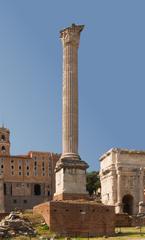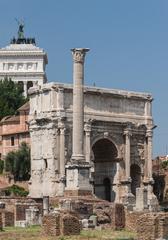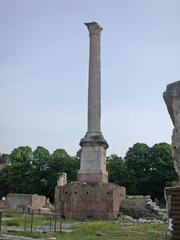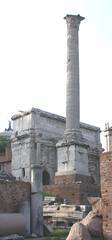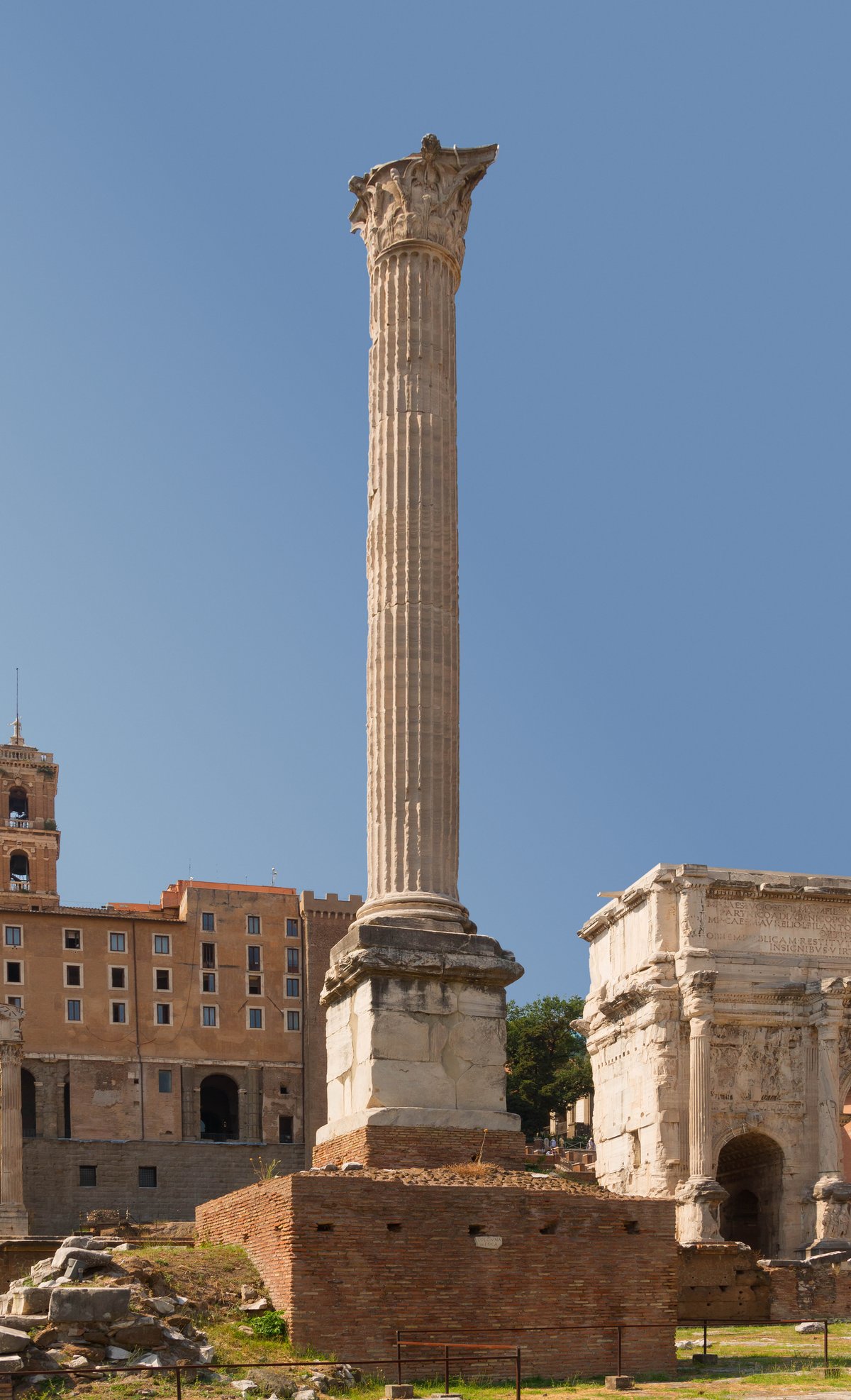
Visiting the Column of Phocas: Rome, Italy Guide
Date: 14/06/2025
Introduction
The Column of Phocas stands as the final monumental addition to the Roman Forum, offering a vivid testament to Rome’s enduring legacy and its transition from the ancient imperial era to the Byzantine and early medieval periods. Erected in 608 CE and dedicated to the Byzantine Emperor Phocas by Smaragdus, the Exarch of Italy, the column both commemorates a turbulent ruler and illustrates the resourceful use of earlier Roman architectural elements through spolia (The Byzantine Legacy; Rome Reborn). Today, it remains one of the best-preserved late antique monuments in Rome, accessible within the UNESCO-listed Roman Forum archaeological park (UNESCO World Heritage Centre).
This comprehensive guide covers the Column of Phocas’s historical background, architectural features, political significance, and practical information for visiting—including hours, tickets, accessibility, and nearby attractions. Whether you’re a traveler, historian, or architecture enthusiast, use this resource to enrich your visit and deepen your understanding of one of Rome’s most evocative historical sites (Parco Archeologico del Colosseo; entrance-fee.com).
Contents
- Introduction
- Historical Background
- Origins and Construction
- Dedication and Political Context
- Architectural Features
- Historical Significance
- Rediscovery and Preservation
- Visiting the Column of Phocas
- Location
- Visiting Hours
- Tickets and Admission
- Accessibility
- Guided Tours and Audio Guides
- Nearby Attractions
- Photography Tips
- Frequently Asked Questions (FAQ)
- Conclusion and Plan Your Visit
- Sources and Further Reading
Historical Background
Origins and Construction
The Column of Phocas was erected on August 1, 608 CE, during a time of significant transition for Rome. The monument was dedicated by Smaragdus, the Exarch of Italy, to honor Emperor Phocas (r. 602–610 CE), reflecting the city’s political shift towards Byzantine influence (The Byzantine Legacy; Ancient Rome Live). The column itself is a striking example of spolia: its fluted, white marble Corinthian shaft and socle were repurposed from a 2nd-century monument, and its base—originally for a Diocletian statue—was re-inscribed for Phocas (Trek Zone; Sights.seindal.dk).
Elevated atop a brick pedestal and a series of tufa steps, the column rises 13.6 meters (44.6 feet) high. The steps, added by Smaragdus for prominence, were partly removed during 20th-century excavations (Ancient Rome Live).
Dedication and Political Context
The Latin inscription praises Phocas as “the greatest, most merciful and most pious ruler,” supposedly celebrating his role in securing peace and freedom for Italy (The Byzantine Legacy). However, Phocas’s reign was marked by violence and instability, and following his overthrow in 610 CE, many dedications were erased or destroyed. The original gilded bronze statue of Phocas that crowned the column was likely removed as part of his damnatio memoriae (Through Eternity Tours).
A key legacy of Phocas was his donation of the Pantheon to Pope Boniface IV, facilitating its conversion into the Christian church of Santa Maria ad Martyres in 609 CE—a pivotal moment in the Christianization of Rome’s monumental landscape (Vatican News).
Architectural Features
The column is an excellent specimen of the Corinthian order, with its ornate capital adorned with acanthus leaves and volutes (Roman Empire.net). The shaft is monolithic white marble, 10.5 meters tall, resting on a 1.8-meter-high cubical marble base. The structure’s use of recycled elements—spolia—was common in late antiquity, reflecting both practical constraints and reverence for Rome’s imperial grandeur (Trek Zone).
Historical Significance
The Column of Phocas occupies a prominent spot in the Forum, near the Rostra and the Arch of Septimius Severus (Ancient Rome Live). As the last monument erected in the Forum, it symbolizes Rome’s shift from imperial capital to a city under Byzantine and papal authority. Its preservation underscores the city’s layered evolution and the enduring impact of political and religious transitions (Rome Reborn; UNESCO World Heritage Centre).
Rediscovery and Preservation
The Column of Phocas survived centuries of burial as the Forum became a pasture known as the “Campo Vaccino.” Rediscovered during excavations in the 18th and 19th centuries, the column’s full form was revealed and stabilized (Ancient Rome Live). Preservation efforts have focused on maintaining its structure and the legibility of its inscription. Today, the column is an integral part of the Roman Forum archaeological park (Official Parco Archeologico del Colosseo).
Visiting the Column of Phocas
Location
The Column of Phocas stands centrally in the Roman Forum, in front of the Rostra and near the Arch of Septimius Severus, making it a striking and easily visible landmark (Wikipedia; Roman Empire.net).
Visiting Hours
The Roman Forum is open daily, typically from 8:30 AM until one hour before sunset. Hours may vary seasonally or during holidays—always check the official website for up-to-date information.
Tickets and Admission
Entry to the Roman Forum, including the Column of Phocas, is available only with a combined ticket that also covers the Colosseum and Palatine Hill. As of 2025, standard tickets cost €18, with reduced rates for EU citizens under 25 and free entry for children under 18. Advance online booking is strongly recommended to avoid long queues (entrance-fee.com; Official Rome Archaeological Sites).
Accessibility
The Roman Forum features uneven terrain and ancient paving stones, which can be challenging for visitors with mobility impairments. Some accessible routes and ramps are available; consult the official site or inquire at the entrance for the best routes (mamalovesrome.com).
Guided Tours and Audio Guides
Guided tours are highly recommended for understanding the Column of Phocas’s context and significance. Many tours bundle the Forum with the Colosseum and Palatine Hill, and audio guides or the official “Parco Colosseo” app offer additional information and suggested itineraries (mamalovesrome.com).
Nearby Attractions
While visiting, explore nearby highlights such as the Arch of Titus, Temple of Saturn, Basilica of Maxentius, House of the Vestals, and, just beyond the Forum, the Colosseum and Capitoline Museums (Rome.info).
Photography Tips
The Column of Phocas is especially photogenic in the early morning or late afternoon, when soft, golden light accentuates its fluted shaft and Corinthian capital (The Geographical Cure; Nomad Epicureans). For panoramic shots, vantage points from the Palatine Hill or Campidoglio are ideal.
Frequently Asked Questions (FAQ)
Q: What are the visiting hours for the Column of Phocas?
A: The monument is accessible during the Roman Forum’s opening hours, generally from 8:30 AM until sunset. Check official sites for seasonal variations.
Q: Is there a separate ticket for the Column of Phocas?
A: No, access is included with the combined Roman Forum/Colosseum/Palatine Hill ticket (entrance-fee.com).
Q: Is the Column of Phocas wheelchair accessible?
A: The Forum has partial accessibility; some areas, including near the column, have uneven terrain. Assistance and accessible paths are available (mamalovesrome.com).
Q: Are guided tours available?
A: Yes, many Forum tours include the Column of Phocas. Audio guides and the official app provide further context.
Q: Can I take photos?
A: Photography is permitted throughout the Forum. The column is especially striking in golden hour and at night.
Conclusion and Plan Your Visit
The Column of Phocas stands as a powerful symbol of Rome’s historical evolution—bridging the grandeur of its ancient empire, the complexities of Byzantine rule, and the transformative arrival of Christianity. As the last monument to grace the Forum, it encapsulates both continuity and change in the city’s storied past.
For the best experience, plan ahead: book tickets in advance, consider a guided tour or audio guide, and explore the surrounding archaeological marvels. The Column of Phocas not only offers a tangible link to Rome’s past but invites reflection on the forces that shaped the Eternal City. Download dedicated mobile apps for interactive maps and guides, and follow official channels for updates and events.
Sources and Further Reading
- The Byzantine Legacy - Phocas Column
- Ancient Rome Live - Column of Phocas
- Trek Zone - Column of Phocas Rome
- Sights.seindal.dk - Column of Phocas
- Through Eternity Tours - What to See in the Roman Forum
- Wikipedia - Column of Phocas
- Roman Empire.net - Roman Columns
- Colosseum Rome Tickets - Column Phocas
- Official Rome Archaeological Sites - Ticketing
- The Geographical Cure - Column of Phocas
- Nomad Epicureans - Visiting Roman Forum
- Rome Reborn - Column of Phocas
- UNESCO World Heritage Centre - Roman Forum
- Oxford Classical Dictionary
- Vatican News - Pantheon Conversion
- Rome Art Lover - Roman Forum
- Encyclopaedia Britannica - Phocas
- Rome.info - Column of Phocas
- Official Parco Archeologico del Colosseo Website
- mamalovesrome.com - Visiting Roman Forum
- entrance-fee.com - Roman Forum Tickets
- finestresullarte.info - Guide to Roman Forum Monuments
